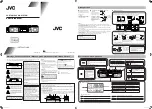
Geographic Load Balancing
Equalizer Installation and Administration Guide
7
When geographic load balancing is enabled, incoming client requests are directed to one of
the sites in the geographic cluster based on the following criteria:
■
Availability
—if a site is unavailable due to network outage, server failure, or any
other reason, Equalizer stops directing requests to that site.
■
Performance
—Equalizer tracks the load and performance at each site and uses this
information to determine which site can process the request most efficiently.
■
Distance
—Equalizer takes into account which site is closest to the client (in network
terms) and offers the least network latency.
Equalizer uses the domain name service (DNS) protocol
1
to perform its geographic load
distribution. DNS is used to translate fully-qualified domain names such as
www.coyotepoint.com
into the IP addresses used to identify hosts on the Internet. The
authoritative name server for the domain is configured to query the Equalizers in the
geographic cluster to resolve the domain name. When Equalizer receives a resolution
request, it uses the load-balancing algorithms configured for the geographic cluster to
determine which site is best able to process the request and then returns the address of the
selected site.
For example, there might be three sites in the geographic cluster
www.coyotepoint.com
,
one in the Eastern U.S., one in the Western U.S., and one in Europe. An Equalizer and a
cluster of servers resides at each of these sites.
Figure 2 Three-site geographic cluster configuration
When a client in California attempts to connect to
www.coyotepoint.com
:
1.
The client’s local name server is queried to resolve the domain name. (Step 1 in Figure
3.)
2.
The local name server queries the authoritative name server for
coyotepoint.com
.
(Step 2 in Figure 3.)
1. For more information about DNS, see Paul Albitz and Cricket Liu, DNS and BIND, 3rd ed. (O'Reilly & Associates, 1998).
Summary of Contents for Equalizer
Page 2: ......
Page 4: ...iv Coyote Point Systems Inc ...
Page 32: ...Chapter 2 Installing Equalizer 22 Equalizer Installation and Administration Guide ...
Page 42: ...Chapter 3 Configuring Equalizer 32 Equalizer Installation and Administration Guide ...
Page 108: ...Chapter 7 Troubleshooting 98 Equalizer Installation and Administration Guide ...
Page 114: ...Appendix B Using Reserved IP Addresses 104 Equalizer Installation and Administration Guide ...
Page 118: ...Appendix C Regular Expression Format 108 Equalizer Installation and Administration Guide ...
Page 130: ...Appendix E Technical Specifications 120 Equalizer Installation and Administration Guide ...
Page 136: ...Appendix F License and Warranty 126 Equalizer Installation and Administration Guide ...
















































